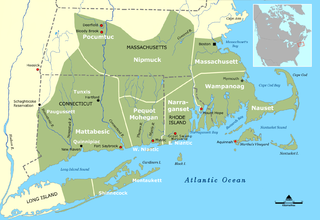
Back Wampanoageg Breton Массачусет чĕлхи CV Massachusett-Sprache German Idioma massachusett Spanish Massachusettin kieli Finnish Massachusett French Lingua massachusett Galician Bahasa Massachusett ID Lingua Massachusett Latin Wampanoag LFN
This article may be too long to read and navigate comfortably. (November 2023) |
| Massachusett | |
|---|---|
| Wampanoag | |
| Massachusee unnontꝏwaonk Mâsach8see unôt8âôk[citation needed] (Muhsachuweesee unôtuwâôk)[1] Wôpanâôtuwâôk[2] | |
| Pronunciation | /məhsatʃəw[iː]see ənãtuwaːãk/ /wãpanaːãˈtuwaːãk/ |
| Native to | United States |
| Region | Eastern Massachusetts, southeastern New Hampshire, and northern and southeastern Rhode Island[3][4] |
| Ethnicity | Massachusett, Wômpanâak (Wampanoag), Pawtucket (Naumkeag, Agawam), Nauset, and Coweset. Neighboring Algonquian peoples as a second language.[5] |
| Extinct | Late 19th century (possibly around 1890)[6][7] |
| Revival | Revitalization from 1993. As of 2014, 5 children are native speakers, 15 are proficient second-language speakers and 500 are adult second-language learners.[8][9] |
| Latin script | |
| Language codes | |
| ISO 639-3 | wam |
wam | |
| Glottolog | wamp1249 |
| ELP | Wampanoag |
 The location of the Massachusett/Wampanoag tribe and their neighbors, c. 1600 | |
The Massachusett language is an Algonquian language of the Algic language family that was formerly spoken by several peoples of eastern coastal and southeastern Massachusetts. In its revived form, it is spoken in four Wampanoag communities. The language is also known as Natick or Wôpanâak (Wampanoag), and historically as Pokanoket, Indian or Nonantum.[10]
The language is most notable for its community of literate Native Americans and for the number of translations of religious texts into the language. John Eliot's translation of the Christian Bible in 1663 using the Natick dialect, known as Mamusse Wunneetupanatamwe Up-Biblum God, was the first printed in the Americas, the first Bible translated by a non-native speaker, and one of the earliest examples of a Bible translation into a previously unwritten language. Literate Native American ministers and teachers taught literacy to the elites and other members of their communities, influencing a widespread acceptance. This is attested in the numerous court petitions, church records, praying town administrative records, notes on book margins, personal letters, and widespread distribution of other translations of religious tracts throughout the colonial period.[11]
The dialects of the language were formerly spoken by several peoples of southern New England, including all the coastal and insular areas of eastern Massachusetts, as well as southeastern New Hampshire, the southernmost tip of Maine and eastern Rhode Island, and it was also a common second or third language across most of New England and portions of Long Island.[7] The use of the language in the intertribal communities of Christian converts, called praying towns, resulted in its adoption by some groups of Nipmuc and Pennacook.[12][13]
The revitalization of the language began in 1993 when Jessie Little Doe Baird (Mashpee Wampanoag) launched the Wôpanâak Language Reclamation Project (WLRP). It has successfully reintroduced the revived Wampanoag dialect to the Mashpee, Aquinnah, Assonet, and Herring Pond communities of the Wampanoag of Cape Cod and the Islands, with a handful of children who are growing up as the first native speakers in more than a century.[14][15]
- ^ Trumbull, J. H. (1903). Natick Dictionary. Washington, D.C.: Government Printing Office. p. 285.
- ^ Baird, J. L. D. (2014). 'Project History.'Archived 2015-11-19 at the Wayback Machine Retrieved 29 December 2015.
- ^ Day, G. M. (1998). M. K. Foster & W. Cowan (Eds.), In Search of New England's Native Past: Selected Essays from Gordon M. Day.
- ^ Ager, S. (1998–2013). "Massachusett (wôpanâak / wampanoag)". Omniglot, the online encyclopedia of writing systems and languages. Accessed 2014-02-26
- ^ Goddard, Ives. 1996. "Introduction." Ives Goddard, ed., The Handbook of North American Indians, Volume 17. Languages, pp. 1–16.
- ^ Speck, F. G. (1928). Territorial Subdivisions and Boundaries of the Wampanoag, Massachusett and Nauset Indians. Frank Hodge (ed). Lancaster, PA: Lancaster Press. p. 46.
- ^ a b Goddard, I., & Bragdon, K. (1988). Native writings in Massachusetts. In Memoirs of the American Philosophical Society (185 ed., p. 20). Philadelphia, PA: American Philosophical Society.
- ^ Saskia De Melker, "'We Still Live Here' Traces Comeback of Wampanoag Indian Language", PBS Newshour, 11-10-2011, accessed 18 November 2011
- ^ Rose, Christina (2014-02-25). "Sleeping Language Waking Up Thanks to Wampanoag Reclamation Project". Indian Country Today Media Network. Archived from the original on 5 March 2014. Retrieved 2014-02-26.
- ^ Costa, D. J. (2007). 'The Dialectology of Southern New England Algonquian'. Wolfart, H. C. (Eds.), Papers of the 38th Algonquian Conference. (pp. 81–127). Winnipeg, Manitoba. Winnipeg, Manitoba: University of Manitoba Press.
- ^ Ricky, D. B. (1999). Encyclopedia of Massachusetts Indians. Hamburg, MI: North American Book Dist LLC. p. 142.
- ^ Connole, D. A. (2007). Indians of the Nipmuck Country in Southern New England 1630–1750: An Historical Geography. Jefferson, NC: McFarland & Co. pp. 41, 90–120.
- ^ Shannon, T. J. (2005). "Puritan Conversion Attempts", Gettysburg College
- ^ Doane, S. (Correspondent) (2012). 'Wampanoag: Reviving the language' [Television news feature]. In CBS News. New York, NY: CBS Broadcast Inc. Retrieved from http://www.cbsnews.com/video/watch/?id=50135817n
- ^ Baird, J. L. D. (2013). Wôpanâak Language Reclamation Project. Retrieved from http://www.wlrp.org/.